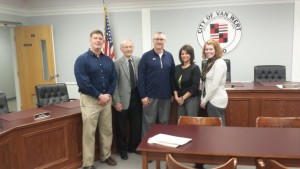
In 2015, the Van Wert City Revolving Loan made five loans totaling over $252,000, which supported the creation of 12 jobs.
Entrepreneurship is a critical component of any community. So, how can we support entrepreneurial growth? One tool available to communities interested in helping entrepreneurs start businesses and facilitating the expansion or relocation of existing businesses is a Revolving Loan Fund (RLF). The principal goal of the RLF is to create and retain private sector jobs, of which 51 percent must be held by persons from low-to-moderate income households. Applicants must document job creation for any RLF money borrowed and one (1) full time equivalent job must be created for every $25,000 increment borrowed. Applicants have two years to fulfill the job requirements. Loans can be made to businesses for land and building acquisition, new construction, building renovations and improvements, machinery and equipment purchases, and working capital. Loans involving construction and building renovations and improvements are subject to national prevailing wage requirements should the labor exceed $2,000.
This program allows businesses to secure fixed low interest rate loans. Two types of loans exist: Economic Development loans and Micro loans; however, each community may not offer both loan types. Most businesses apply for an Economic Development loan, which is a combination of owner equity, private funding (bank loan), and RLF money, to secure their project financing. Economic Development loans can be made for up to 50 percent of the project total. The Micro Loan option allows for RLF money to be the sole funding source for businesses with five or fewer employees undergoing projects less than $35,000 and capable of meeting the income requirements.
For more information, please visit the Ohio Development Services Agency Community and Economic Development Programs page. Communities interested in starting a revolving loan fund should review the information on the PY 2016 CDBG Community Development Program Notice of Funding Availability (NOFA) and Training Forum announcement and submit their application by Friday, June 17, 2016.
(Submitted by Caitlin Jones, Program Coordinator, Van Wert County & Maumee Valley EERA)

 As one of the many educational exhibitors at this event, Ohio Sea Grant was thrilled to be able to teach about the importance of a healthy Lake Erie to the
As one of the many educational exhibitors at this event, Ohio Sea Grant was thrilled to be able to teach about the importance of a healthy Lake Erie to the  many visitors that attended. Stationed next to a singing pirate and personal watercraft simulator, we had some stiff competition. However, neither could stand up to the fright, ick, “Oh geez! That’s a live snake!” factor of our Stone Laboratory snakes and the
many visitors that attended. Stationed next to a singing pirate and personal watercraft simulator, we had some stiff competition. However, neither could stand up to the fright, ick, “Oh geez! That’s a live snake!” factor of our Stone Laboratory snakes and the  As you might imagine, visitors were mainly concerned about invasive species, harmful algal blooms (
As you might imagine, visitors were mainly concerned about invasive species, harmful algal blooms ( An effective execution plan starts with committing to a series of 15-minute segments on planning and implementing the strategic plan. Franklin Covey’s
An effective execution plan starts with committing to a series of 15-minute segments on planning and implementing the strategic plan. Franklin Covey’s